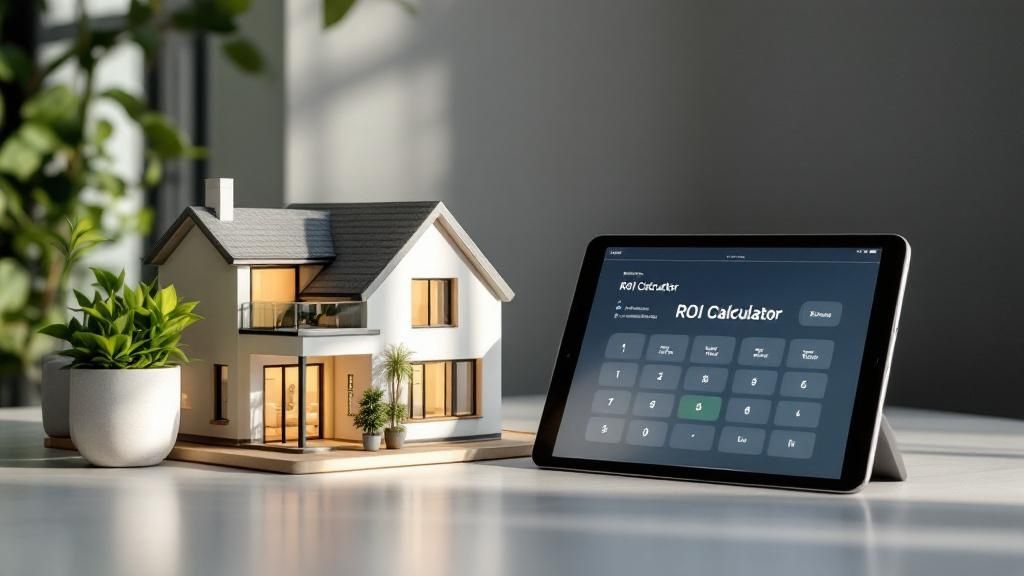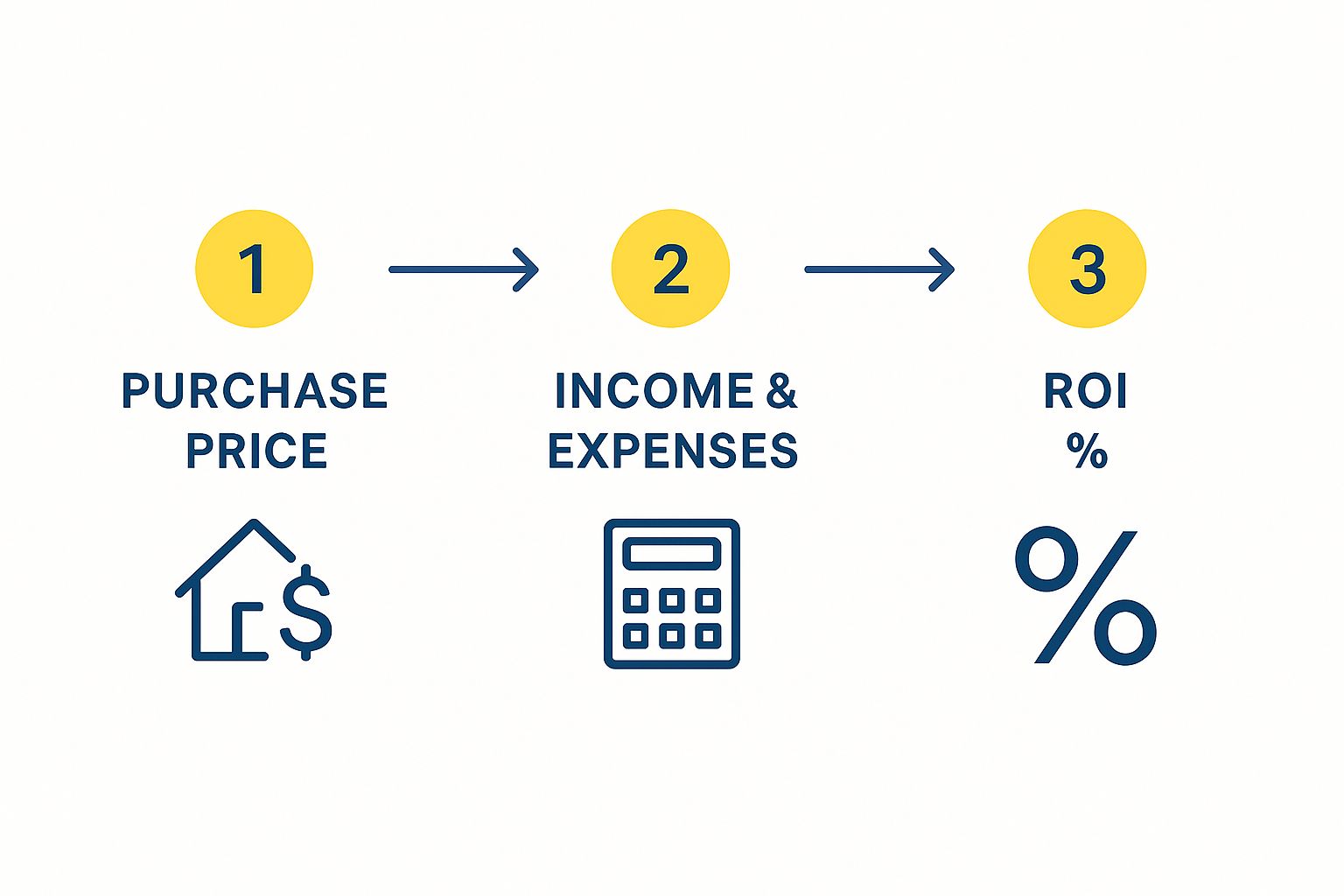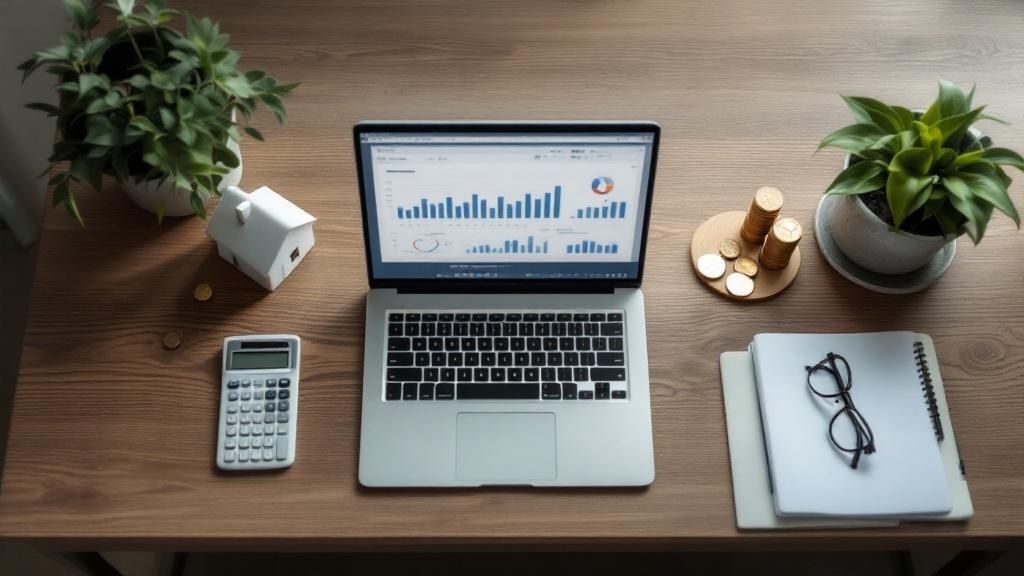When you're trying to figure out if a rental property is a good buy, a precise ROI calculation is your best mate. It cuts through the noise and shows you the real financial health of your investment, going way beyond just the rent you collect each week.
Knowing this number is crucial. It's the difference between making a smart decision—like holding, selling, or refinancing—and just guessing. Honestly, it's the most powerful tool you have for building long-term wealth in Australia's competitive property market.
Why Nailing Your ROI Calculation is Your Biggest Advantage

Figuring out your rental property's Return on Investment (ROI) isn't just some boring accounting task. Think of it as the heart of your investment strategy. It gives you a clear, unbiased look at how hard your money is really working for you.
With a solid ROI figure, you can compare different properties on a level playing field, no matter their purchase price or how much rent they pull in. This kind of clarity means you can stop relying on gut feelings or market hype and start making sharp, data-driven decisions that line up with your financial goals.
Looking Past the Surface-Level Numbers
It's easy for new investors to get fixated on gross rental yield, but that number can be seriously misleading. Why? Because it completely ignores all the expenses that are quietly eating into your profits.
A proper ROI calculation, on the other hand, factors in everything.
We're talking about:
- Upfront costs like stamp duty and legal fees.
- Ongoing expenses such as council rates, insurance, and property management fees.
- The true cost of your mortgage, if you've got one.
When you dig into these details, you uncover the actual net income your property is generating. This detailed view is what separates the successful investors from those who end up struggling.
ROI isn’t just a number; it’s the story of your investment. It tells you everything from the day you bought the place to how it’s performing now, pointing out where you can tweak things for better returns.
What This Means in the Aussie Market
In Australia's fast-moving property market, knowing your returns is more critical than ever. We've seen a trend where the national average gross rental yield is sitting at around 3.74%, the highest it’s been since 2019. That's mainly because rents have been climbing faster than property values, which sounds great for investors.
But this is exactly why you need to be on the ball. You have to factor in real-world costs like property management and the chance of vacancies to make sure your numbers aren't just wishful thinking. For a deeper dive into the Aussie rental market and its yields, you can find some great insights on Wise.com.
Gathering the Essential Data for Your ROI Calculation

Any rental property ROI calculator is only as good as the numbers you put into it. It’s a classic case of "garbage in, garbage out." To get a real, honest look at how your investment is performing, you need to dig deeper than just the sale price and account for every single dollar spent.
Getting this right starts with tallying up your total initial investment. This isn't just the price on the contract; it’s every cent you spent to get the property ready for that very first tenant. Think of it as your true "all-in" cost.
Your Upfront Investment Costs
Before a single rent payment hits your bank account, you’ve already laid out a fair bit of cash. A proper ROI calculation has to include all of these one-off expenses. You need to be meticulous here because even a small oversight can throw your final numbers off track.
To get your total initial investment figure, you'll need to pull together:
- The purchase price of the property.
- Stamp duty, which is often one of the biggest upfront costs and varies by state.
- All legal and conveyancing fees paid to the professionals who handled the sale.
- Initial renovation or repair costs—any money you spent fixing the place up to make it tenant-ready.
- Building and pest inspection fees, a non-negotiable part of your due diligence.
Tip from experience: Your settlement statement from the conveyancer is an absolute goldmine for this. It itemises most of these acquisition costs, making it the perfect document to start with.
Tracking Ongoing Operational Expenses
Once you've got your starting costs sorted, it’s time to list every recurring expense. These are the costs that chip away at your rental income throughout the year, and they are absolutely crucial for calculating your net profit. Don't just guess or estimate—track them properly using your bank statements or accounting software.
The main operational costs you need to have on your list are:
- Council and water rates.
- Landlord insurance to protect your asset.
- Property management fees, which typically sit around 8-12% of your rental income.
- Strata or body corporate levies if you own a unit, apartment, or townhouse.
- Repairs and maintenance. Be realistic here. A good rule of thumb is to budget 1-2% of the property’s value each year for this.
- Mortgage interest for the year (just the interest portion, not the principal).
To help you get organised, here’s a checklist of all the numbers you’ll need to pull together for a truly accurate calculation.
Essential Data for Your ROI Calculation
| Category | Data Point | Example Figure (AU$) |
|---|---|---|
| Upfront Costs | Purchase Price | $600,000 |
| Stamp Duty | $22,000 | |
| Legal & Conveyancing Fees | $2,500 | |
| Initial Renovations | $15,000 | |
| Inspection Fees | $650 | |
| Annual Income | Gross Rental Income | $31,200 ($600/week) |
| Annual Expenses | Council & Water Rates | $2,800 |
| Landlord Insurance | $1,500 | |
| Property Management Fees | $2,808 (9% of rent) | |
| Strata/Body Corporate Fees | $4,000 | |
| Repairs & Maintenance | $3,000 | |
| Annual Mortgage Interest | $18,000 |
Compiling this list might feel like a bit of work, but it's the only way to ensure the ROI figure you get is one you can actually trust and use to make smart decisions about your portfolio.
Getting to Grips with the Two Main ROI Formulas
To really get a clear picture of how your investment is performing, you need to look beyond a simple rental property ROI calculator. It's about understanding the two key formulas that do all the heavy lifting: the Cost Method (which you'll often hear called Simple ROI) and the all-important Cash on Cash Return.
Think of it this way: each formula tells a different, but equally important, part of your investment's story.
Simple ROI gives you that big-picture, birds-eye view of profitability against the property's total cost. On the other hand, Cash on Cash Return is the metric every investor using finance needs to live by. It zeros in on how hard the actual cash you've tipped in is working for you.
The Simple ROI Formula (Cost Method)
Let's start with the Cost Method. It's refreshingly straightforward. All you're doing is measuring your annual net profit against what the property cost you in total, including all those pesky acquisition fees.
The formula looks like this: Annual Net Profit / Total Investment Cost = Simple ROI
Let's put some real numbers to it. Say you buy a place in Adelaide for $550,000. Once you've paid for stamp duty, legal fees, and a few minor cosmetic updates, your total cost blows out to $580,000. For the year, the property brings in a net profit of $20,000 (that’s your rental income minus all your operating expenses).
Plugging that into the formula, you get: $20,000 / $580,000 = 3.45% Simple ROI.
This number gives you a solid baseline for the asset's overall profitability. It's a handy, no-frills starting point.

The Power of Cash on Cash Return
Now for the real magic, especially if you've taken out a mortgage: Cash on Cash Return. This is where things get interesting because this formula measures your annual net profit against only the cash that came directly out of your bank account.
The formula is: Annual Net Profit / Total Cash Invested = Cash on Cash Return
Let's use our Adelaide property again. That $580,000 total cost wasn't all your money, right? You put down a $116,000 deposit (20%) and had other initial cash outlays of about $30,000. So, your total cash invested is $146,000.
Using the same annual net profit of $20,000, the calculation changes dramatically: $20,000 / $146,000 = 13.7% Cash on Cash Return.
See how much higher that figure is? That’s the power of leverage in action. Your return is calculated on your relatively small cash contribution, not the entire property value.
Knowing both formulas is crucial for making smarter decisions, from choosing the right property to making sure you have quality tenants who protect your cash flow. On that note, our guide on how to screen tenants has some practical tips to help lock in reliable income.
Don't Forget Capital Growth: The Other Half of Your Return

A rental property’s true value isn't just about the weekly rent hitting your bank account. While that rental income is the engine that keeps your investment chugging along, capital growth is the secret sauce that builds serious, long-term wealth. If you ignore it, you’re only seeing half the picture.
Think of it this way: a property with a so-so rental yield in a high-growth suburb can still turn out to be a phenomenal investment. This is precisely why a simple rental property ROI calculator that only looks at rent can be misleading. To really understand your investment's power, you need to calculate your Total Return, which pulls together both your rental income and the property's appreciation.
How Appreciation Supercharges Your Investment
Capital growth, or appreciation, is the increase in your property's market value over time. It’s not cash you can spend at the shops until you sell or refinance, but it’s a massive part of your overall profit. An investment that barely breaks even on cash flow could still be a roaring success if its value doubles over a decade.
We see this principle play out all the time in certain Aussie suburbs. Take an area like Mandurah in Western Australia, which has shown investors how to achieve some pretty impressive results. A median-priced unit there, say around $550,000, might generate a solid rental yield. But when you factor in the recent annual capital growth rates of over 32%, the total return goes through the roof.
It's this blend of decent rent and powerful price growth that can deliver returns far beyond the national average. You can explore more insights on top-performing investor suburbs to see this in action.
Realising the dual power of income and growth is fundamental. Focusing solely on one over the other is a common mistake that can lead you to overlook Australia’s best investment opportunities.
How to Make an Educated Guess on Future Growth
Look, no one has a crystal ball. But you can absolutely make an educated assessment of a property's growth potential. It involves looking beyond the four walls of the property and analysing the bigger picture of the suburb and region.
Keep an eye out for these key drivers:
- Infrastructure Development: Are new train lines, motorways, hospitals, or schools being built? Big-ticket projects like these create jobs and make a suburb a much more attractive place to live.
- Population Trends: Is the local population on the rise? Dig into migration data and demographic shifts that point to growing demand for housing in the area.
- Historical Performance: Check out how the suburb has performed over the last five to ten years. While past performance is no guarantee of future results, it can show you an area's resilience and underlying potential.
Short-Term vs. Long-Term Rentals: A Different Ball Game for ROI
Deciding between a short-term let and a traditional long-term lease isn't just a lifestyle choice—it completely changes how you'll crunch the numbers on your rental property ROI calculator. Each path has its own financial personality, with different income potential and hands-on demands you absolutely need to factor in.
A long-term tenancy is all about stability. Once that lease is signed, you've got a predictable stream of monthly income and, generally speaking, a lot less day-to-day hassle. Your big costs are the usual suspects: rates, insurance, and the odd repair job. This makes for a pretty straightforward ROI calculation.
On the other hand, dipping your toes into the short-term rental market with something like an Airbnb throws a whole lot more variables into the mix. The potential for a higher gross income is definitely tempting, but it comes with a side of extra complexity and costs.
How Your Calculation Needs to Adapt
For a short-term rental, your ROI calculation can't be static; it needs to be dynamic. You're dealing with expenses that simply don't exist for long-term landlords.
Think about things like:
- Platform Fees: Airbnb or Vrbo will skim a percentage off every single booking.
- Constant Cleaning Costs: The property needs a professional clean between every single guest. This adds up fast.
- Higher Utility Bills: Guests on holiday tend to be a bit more liberal with the heating and air conditioning than a long-term tenant would be.
- Furnishing and Supplies: You're on the hook for everything, from the bed and sofa to restocking coffee pods and loo paper.
Your income isn't a fixed monthly figure, either. It swings with seasonal demand and occupancy rates. For a real-world example, a deep dive into the Sydney market shows the average Airbnb host hits an occupancy rate of about 77%, pulling in around AU$65,000 a year. If you want to get granular, you can explore the full revenue data on Airbtics.com.
Here’s the main thing to remember: a bigger gross revenue from short-term lets doesn't automatically equal a better ROI. The extra operational grind and fluctuating income demand some seriously sharp management to turn that potential into actual profit.
This hands-on management style is a huge consideration for your own time and energy. Nailing your property management efficiency is non-negotiable if you want to protect your returns (and your sanity). It’s a level of involvement that just isn’t required with a long-term tenant.
Ultimately, the right strategy for you is the one that lines up with both your financial goals and how much you really want to be involved in the day-to-day running of your investment.
Got Questions About Rental Property ROI?
Even after you've run the numbers through a rental property ROI calculator, it's completely normal to have a few questions buzzing around. The spreadsheet tells one story, but as any seasoned investor knows, the real world loves to throw a few curveballs. Let's tackle some of the most common queries we hear from Aussie investors.
What’s a Good ROI for a Rental Property in Australia?
Look, there’s no single magic number here. What counts as a "good" ROI really boils down to your personal goals, the specific location you're investing in, and how much risk you're comfortable with.
That said, many experienced Aussie investors aim for a cash on cash return somewhere in the 8% to 12% range. Hitting these numbers usually means you’ve got a healthy, cash-flow-positive asset on your hands.
Of course, your Total ROI, which bakes in capital growth, can be much higher—but it's also a lot more speculative. The real key is to measure your property's potential ROI against other investment types and, more importantly, the averages for your specific suburb, not just some vague national figure.
A property with a lower cash on cash return in a high-growth area might still be a far better long-term bet than a high-yield property in a market that's gone flat. It's all about striking that balance between your immediate cash flow needs and your future wealth goals.
How Do I Factor in Vacancy Periods?
This is a big one, and it's something you can't afford to ignore. To account for potential vacancies, you need to subtract an estimated loss of income from your annual gross rent.
A smart and conservative way to do this is to budget for a 2-4% vacancy rate, even if the rental market feels tight.
For instance, if your property rents for $26,000 a year ($500/week), this means docking your expected income by $520-$1,040. That covers you for one or two weeks of downtime between tenants. For the most accurate picture, always check the current average vacancy rates for your specific postcode.
Should I Include Tax Benefits in My ROI Calculation?
Great question. To get a clean read on the property's performance as a standalone asset, it’s best to first calculate your ROI on a pre-tax basis. This gives you a clear, simple number you can use to compare different properties apples-to-apples.
However, for your own personal financial planning, calculating an 'after-tax' ROI is incredibly valuable. This is where you start factoring in goodies like depreciation and the impact of negative gearing on your taxable income. For a deeper dive, our guide on understanding rental property tax deductions is a great starting point, but we always recommend having a chat with a qualified tax advisor to get advice tailored to your situation.
Tired of missed calls from potential tenants or agents costing you opportunities? OnSilent filters the noise and organises your communications, so you only focus on what matters. Never miss a critical call again and manage your properties more effectively by visiting https://onsilent.com.

